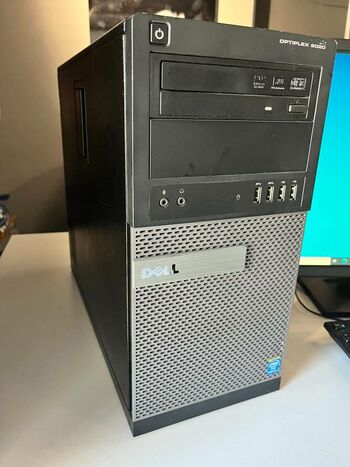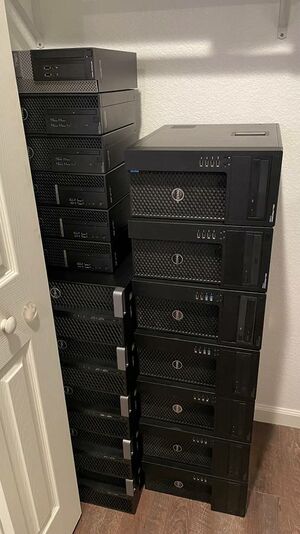We are still actively working on the spam issue.
Difference between revisions of "Home Server/Old Desktop Machines"
(→Hardware Recommendations) |
(→Buying guide) |
||
| (2 intermediate revisions by 2 users not shown) | |||
| Line 10: | Line 10: | ||
* Ubiquitous and easy to source. | * Ubiquitous and easy to source. | ||
* Upgrades are cheap. | * Upgrades are cheap. | ||
| − | * | + | * Often geared towards power efficiency, with high-efficiency power supplies (see caveat below) and configured for low idle power. For example, HP use PSUs that are rated 80+ Platinum - other vendors use similar, though perhaps without the 80+ markings. They do this to comply with myriad power efficiency regulations in Europe and elsewhere. |
===Cons=== | ===Cons=== | ||
| Line 16: | Line 16: | ||
* No support. | * No support. | ||
* You will probably encounter performance bottlenecks if your system has earlier SATA/PCIe/SAS/USB revisions. | * You will probably encounter performance bottlenecks if your system has earlier SATA/PCIe/SAS/USB revisions. | ||
| + | * Limited upgrade paths - almost all motherboards are proprietary form factors fitting only that specific chassis, and power supplies are commonly 12v-only units for which it can be challenging and costly to find a replacement. | ||
| + | * Locked down BIOS/UEFI firmware - don't expect to be able to overclock or really do anything beyond the bare minimum of selecting boot device and maybe adjust memory speeds if you're lucky. Conversely, some more recent systems come with built-in handy diagnostic tools. You may be able to flash an unlocked/modded bios yourself. | ||
==Important Notes== | ==Important Notes== | ||
* Make sure the system is 64bit. 32bit systems are very old, avoid at all costs. | * Make sure the system is 64bit. 32bit systems are very old, avoid at all costs. | ||
| − | * Some | + | * Some ancient systems do not support UEFI and thus cannot boot UEFI OSs. Anything newer than Intel Sandy Bridge is unlikely to have this issue. Microsoft required vendors to support UEFI for Windows 8, if your system originally shipped with an OEM copy of Windows 8 or later, UEFI support is virtually guaranteed. |
| − | * Some very old (8-10 years) high-end CPUs actually perform worse than modern low-to-mid end CPUs. | + | * Some very old (8-10 years) high-end CPUs actually perform worse than modern low-to-mid end CPUs. Check with [https://www.cpubenchmark.net/singleCompare.php Passmark] at the very least. |
| + | * Don't buy Pentium 4 or Core 2 systems, even at the comical prices you can find them for nowadays (<$10 each in job lots!) they are useful only as space heaters. | ||
==Hardware Recommendations== | ==Hardware Recommendations== | ||
| − | Not an expansive list, just an introduction | + | Not an expansive list, just an introduction. |
===Dell OptiPlex=== | ===Dell OptiPlex=== | ||
| Line 31: | Line 34: | ||
The OptiPlex line stretches back to the '90s, so make sure you double-check that yours was made in the last 10 years or so. | The OptiPlex line stretches back to the '90s, so make sure you double-check that yours was made in the last 10 years or so. | ||
| + | |||
| + | ===Others=== | ||
| + | HP (Prodesk, Elitedesk) and Lenovo (Thinkcentre) are the other largest manufacturers to look out for. | ||
| + | There may be systems available from smaller regional system integrators. In the UK the most common ones are Stone and Viglen. These have the advantage of often using off the shelf consumer DIY components or minor cost-decreased revisions thereof. Think standard low-mid range mATX boards from MSI or ASUS, with less bling and reduced power delivery circuitry. | ||
===Thin Clients=== | ===Thin Clients=== | ||
| − | See [[Home_Server/Single_Board_Computers#Intel_NUCs_and_Thin_clients]] | + | See [[Home_Server/Single_Board_Computers#Intel_NUCs_and_Thin_clients]] for a lower-power alternative. |
| + | |||
| + | ==Buying guide== | ||
| + | *Start with a wide ebay search, ie for "i5 8gb". Identify a specific processor model from the generation most fitting your budget. Check Passmark or Geekbench to quickly compare relative performance of different CPUs. | ||
| + | *The usual sweet spot is in the 3-5 year range as that is when corporate systems tend to come off lease. You'll see a sharp increase in prices for used hardware under 3 years for this reason, though deals can still be found on last-gen stock that never sold. Right now that means Haswell or | ||
| + | *Search on ebay using the processor name, as that is the only specification of any real importance. Specific vendor matters little, memory is ubiquitous and cheap, spinning disks will likely warrant replacement. It may be worth it to buy a system with an SSD included, use your brain. | ||
| + | *i7 cpus tend to command significantly more money for little real benefit. Its not uncommon to see older i7 systems selling for more than younger i5 systems that outperform them. | ||
Latest revision as of 03:21, 30 March 2024
Used desktop computers can be found anywhere for under $200. These things always come with a respectable CPU and a decent amount of RAM. The larger ones usually hold up to 4 disks, making them a huge step up from single board computers. Used hardware offers a tremendous amount of potential at a relatively cheap price.
Contents
Pros
- Excellent balance of cost vs. performance.
- Come pre-built and ready to work.
- Ubiquitous and easy to source.
- Upgrades are cheap.
- Often geared towards power efficiency, with high-efficiency power supplies (see caveat below) and configured for low idle power. For example, HP use PSUs that are rated 80+ Platinum - other vendors use similar, though perhaps without the 80+ markings. They do this to comply with myriad power efficiency regulations in Europe and elsewhere.
Cons
- No warranty.
- No support.
- You will probably encounter performance bottlenecks if your system has earlier SATA/PCIe/SAS/USB revisions.
- Limited upgrade paths - almost all motherboards are proprietary form factors fitting only that specific chassis, and power supplies are commonly 12v-only units for which it can be challenging and costly to find a replacement.
- Locked down BIOS/UEFI firmware - don't expect to be able to overclock or really do anything beyond the bare minimum of selecting boot device and maybe adjust memory speeds if you're lucky. Conversely, some more recent systems come with built-in handy diagnostic tools. You may be able to flash an unlocked/modded bios yourself.
Important Notes
- Make sure the system is 64bit. 32bit systems are very old, avoid at all costs.
- Some ancient systems do not support UEFI and thus cannot boot UEFI OSs. Anything newer than Intel Sandy Bridge is unlikely to have this issue. Microsoft required vendors to support UEFI for Windows 8, if your system originally shipped with an OEM copy of Windows 8 or later, UEFI support is virtually guaranteed.
- Some very old (8-10 years) high-end CPUs actually perform worse than modern low-to-mid end CPUs. Check with Passmark at the very least.
- Don't buy Pentium 4 or Core 2 systems, even at the comical prices you can find them for nowadays (<$10 each in job lots!) they are useful only as space heaters.
Hardware Recommendations
Not an expansive list, just an introduction.
Dell OptiPlex
Dell's OptiPlex line is a "business-oriented desktop and all-in-one computers made for corporate enterprises, healthcare, the government, and education markets." These things are all over Ebay and Craigslist.
The OptiPlex line stretches back to the '90s, so make sure you double-check that yours was made in the last 10 years or so.
Others
HP (Prodesk, Elitedesk) and Lenovo (Thinkcentre) are the other largest manufacturers to look out for. There may be systems available from smaller regional system integrators. In the UK the most common ones are Stone and Viglen. These have the advantage of often using off the shelf consumer DIY components or minor cost-decreased revisions thereof. Think standard low-mid range mATX boards from MSI or ASUS, with less bling and reduced power delivery circuitry.
Thin Clients
See Home_Server/Single_Board_Computers#Intel_NUCs_and_Thin_clients for a lower-power alternative.
Buying guide
- Start with a wide ebay search, ie for "i5 8gb". Identify a specific processor model from the generation most fitting your budget. Check Passmark or Geekbench to quickly compare relative performance of different CPUs.
- The usual sweet spot is in the 3-5 year range as that is when corporate systems tend to come off lease. You'll see a sharp increase in prices for used hardware under 3 years for this reason, though deals can still be found on last-gen stock that never sold. Right now that means Haswell or
- Search on ebay using the processor name, as that is the only specification of any real importance. Specific vendor matters little, memory is ubiquitous and cheap, spinning disks will likely warrant replacement. It may be worth it to buy a system with an SSD included, use your brain.
- i7 cpus tend to command significantly more money for little real benefit. Its not uncommon to see older i7 systems selling for more than younger i5 systems that outperform them.

